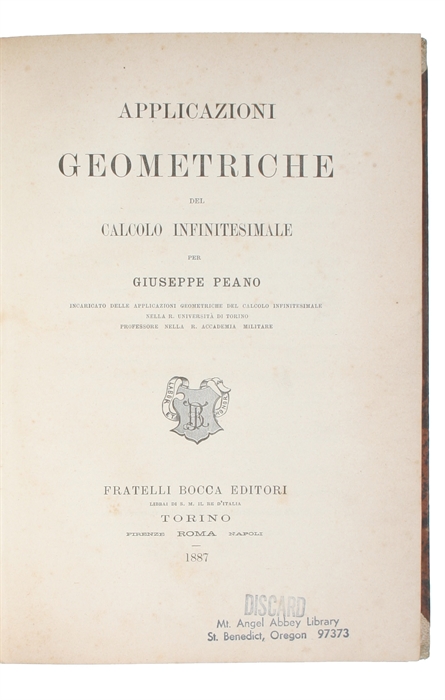THE "GEOMETRICAL CALCULUS"
PEANO, GUISEPPE.
Applicazioni geometriche del calcolo infinitesimale.
Torino, Bocca, 1887. Large 8vo. Cont. half vellum binding with gilt leather title-label to spine. Old library-mark rather crudely removed from back. Inner front hinge a bit weak. A bit of brownspotting. Library-stamp to title-page. XII, 334, (2) pp.
The rare first edition of the work in which Peano introduces the basic elements of geometric calculus and gives new definitions for the length of an arc and for the area of a curved surface.
The famous Italian mathematician, logical philosopher, pioneer of symbolic logic, and a founder of mathematical logic and set theory, Giuseppe Peano (1858 -1932), studied mathematics at the University of Turin, where he was employed just after graduating (1880), and where he stayed almost all of his life, devoting his life to mathematics. After having graduated with honours, he was employed to assist first Enrico D'Ovidio, and then the renowned Angelo Genocchi, who possessed the chair of Infinitesimal calculus. In 1890 Peano became extraordinary professor, and in 1895 ordinary professor, of infinitesimal calculus at the Unversity of Turin.
His important work "Geometrical Applications of Infinitesimal Calculus" is based on Peano's lectures on infinitesimal calculus and its application to geometry from 1885. In the important work he introduced his geometrical calculus and presented several new geometrical discoveries.
"The treatise "Applicazioni geometriche del calcolo infinitesimal" (1887) was based on a course Peano began teaching at the University of Turin in 1885 and contains the beginnings of his "geometrical calculus" (here still influenced by Bellavitis' method of equipolences), new forms of remainders in quadrature formulas, new definitions of length of an arc of a curve and of area of a surface, the notion of a figure tangent to a curve, a determination of the error term in Simpson's formula, and the notion of the limit of a variable figure. There is also a discussion of the measure of a point set, of additive functions of sets, and of integration applied to sets. Peano here generalized the notion of measure that he had introduced in 1883." (D.S.B. X:443).
Order-nr.: 38823


